I never tire of jumping into newspaper archives in search of one item, only to find something far more eye-opening, or intriguing, or informative. I am always happy to share those findings, but seldom do my press clippings fit in perfectly with one of my regular blog posts. Since the beginning of the year I have shared some on two Facebook groups: Franco-American Connection and Le rêve de Gagnon. There is considerable overlap between these groups, but the first is more focused on the culture and history of the French-Canadian diaspora whereas the second is resolutely committed to forging closer ties between Quebeckers and Franco-Americans aujourd’hui. Of course, not everyone is on Facebook—and God bless you brave souls—so, since this rerun season, I am pleased to provide such miscellanea here.
Pioneering Figures (1844-1856)
In the last quarter of the nineteenth century, it was a small group of French-Canadian men who organized “national” societies, edited French-language newspapers and regularly attended ethnic congresses in the U.S. Northeast. This map represents the Quebec birthplaces of these prominent figures; some immigrated with parents, as children, and others well into adulthood. Many of them were educated in Saint-Hyacinthe; by the turn of the century more and more were attending classical colleges in Sherbrooke and Sainte-Marie-de-Monnoir. See my prior posts for more information about Major Mallet and Benjamin Lenthier.
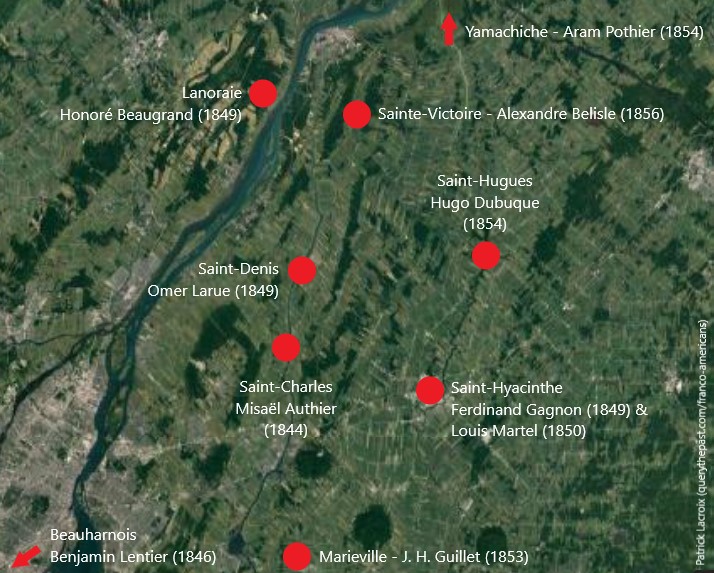
A Flag for Quebec (1905)
Sure, Quebec’s official flag was adopted by decree in 1948, but it has a much longer history. Already, in the early twentieth century, a flag closely resembling the current one was a symbol of French Canada. Derived from the “flag of Carillon [Ticonderoga],” it may stand for a lengthy French cultural presence that transcends present-day political boundaries. See here for more information on the Carillon flag or banner.

Deportation Days (1922)
Many of us have not-so-fond memories of dubious “border” checkpoints on I-93. Along the northern border, the type of INS-led immigration oversight and control that are recognizable today got their start in the 1920s—before Depression-era immigration restriction, and even before the Johnson-Reed immigration bill of 1924. At that point, it was as much about preventing liquor smuggling as checking whether a person was “legal.”
As I have found in my work on the contemporary Barre granite strike, the taxi ploy described here was surprisingly common in the early 1920s.
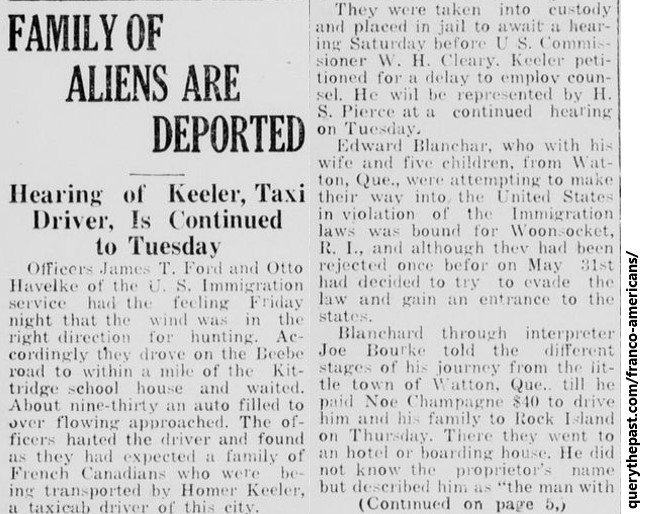
Immigration, Part II (1900-1930)
As a whole, immigration from Quebec slowed considerably around the turn of the century—for reasons we may get into in a future blog post. But by no means did it end. More and more French Canadians moved to Vermont following the First World War (often to farm) or to pulp and paper centers (Rumford, Maine, for instance) whose labor needs were still growing. Only one of these counties includes one the five “crown jewels” (most prominent Franco-American centers): Lewiston is located in Androscoggin County, Maine.
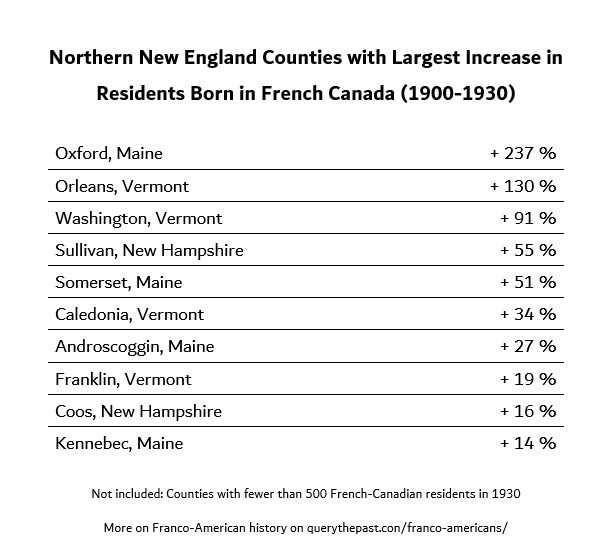
E Pluribus Unum (1938)
We must take care not to minimize the very real winds of nativism and xenophobia of the interwar period, but we must also acknowledge genuine expressions of good will, as in this 1938 clipping.
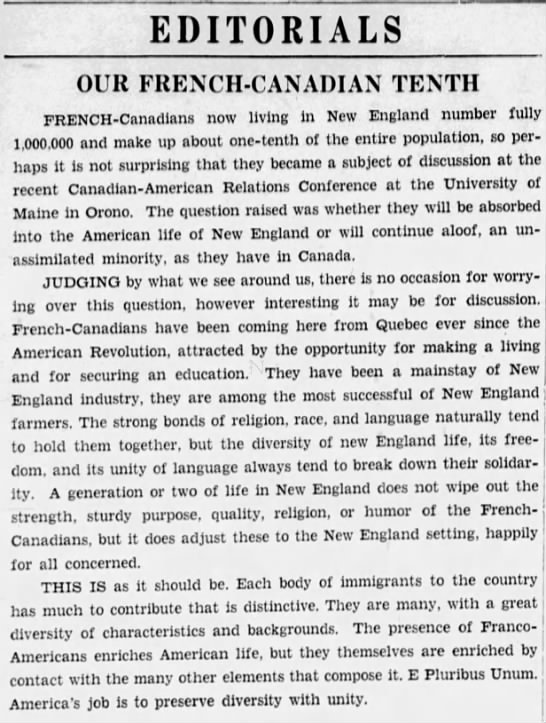
The New Nationalism (1960-1961)
La Presse, the venerable Montreal newspaper, ran its last regular news column on Franco-Americans on July 4, 1960, a day before Quebec’s premier-elect, Jean Lesage, a symbol of the new nationalism sweeping the province, was sworn in. A year later, Lesage visited Franco-American centers in New England and pledged Quebec’s friendship and support.
Since then, provincial governments have emphasized a shared cultural background when reaching out to partners in New England; to this day, every few years, Quebec newspapers send a reporter down to “rediscover” Franco-Americans. But the tenor of cross-border relations—among people of French-Canadian descent—changed considerably in the aftermath of the Second World War. Despite Premier Lesage’s pledge to support Francos in their endeavors, expatriated compatriots faded from Quebec’s mental horizons.
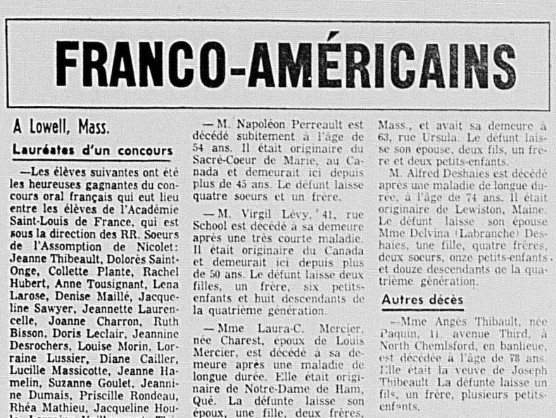
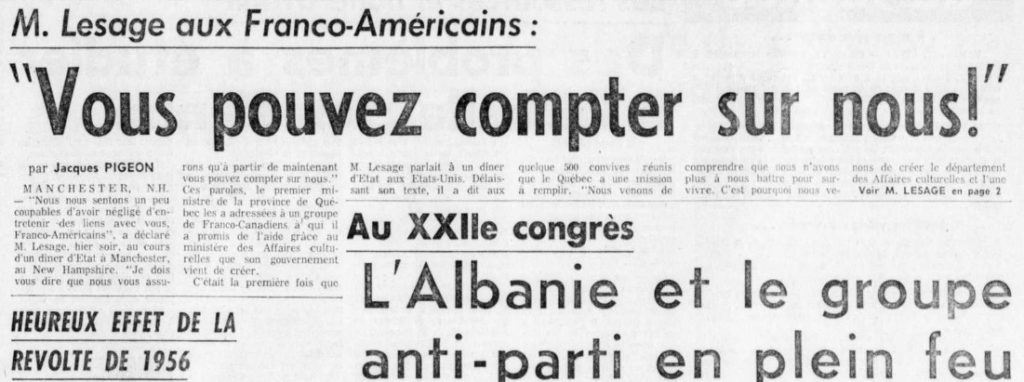
Questions? Please feel free to ask or to comment below! And, when sharing, please be sure to cite appropriately.
Leave a Reply